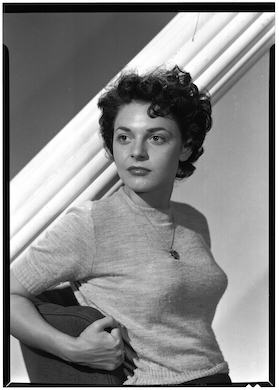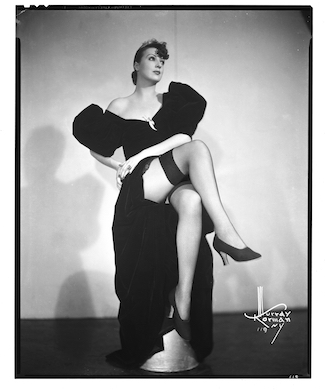The Art of Murray Korman’s ‘Cheesecake’
The photographer showed his subjects as they wanted to be depicted, suggesting poses and positions that delighted them. Women wanted to look like a Korman photograph.

‘Vintage Babes of Broadway: Through the 20th Century Lens of Murray Korman’
By Clyde Adams and Maureen McCabe
The One Big Name Publishing, 180 pages
A Ukrainian-born American immigrant named Murray Korman dominated celebrity photography in New York City between the late 1920s and the early 1950s. His work is often called “cheesecake,” as if all he had in mind was depicting half-dressed beautiful women in provocative postures. He did so, but his photographs say much more about himself and his subjects than the label would suggest.
Black-and-white photographs of Anne Bancroft in the early 1950s at the start of her acting career are a study in self-possession. A profile shot with her right hand placed with fingers outspread against her neck as her head tilts upward complements the accompanying text that quotes her wish to be “famous and popular and powerful and rich.”

Photographs of a blonde Bancroft — no longer a brunette in a sweater but a babe in a swimsuit — and another in a dress giving us the full frontal look: lips closed, piercing eyes, commanding attention as if to say, “I can play anything.” It is the expressive nature of Korman’s work that entices attempts to caption it.
Just as stunning is Korman’s portrayal of an unstripped Gypsy Rose Lee: a low-angle shot of her seated on a metal pedestal, legs crossed, with one stocking top showing. Above her right knee, her hands are clasped in what might be called part of a side-saddle position. Wearing a flowing dress with puffy sleeves, she looks up and away, unavailable.
Korman did this kind of work every day for more than 20 years. Where did he get his ideas for photographs? Well, he began as a sketch artist, which meant he had to observe with precision and deliver quickly to daily newspapers. He turned to photography because it was faster, and yet he never seems to have become lazy about observing his subjects.

The photographer showed his subjects as they wanted to be depicted, suggesting poses and positions that delighted them — as one can see in photographs of him at work. Women wanted to look like a Korman photograph, which is why he also set up a studio for the carriage trade. That outmoded term for a wealthy clientele suggests the breadth of Korman’s appeal.
I suspect Korman discovered ideas for photographs by always working — not only in the studio but in the nightclubs that were his favorite haunt. Wherever he was at the moment became a form of entertainment for himself and his models.
The text that accompanies the photographs is serviceable if cliché-ridden, and includes some misspellings and the misidentification of Buster Crabbe as Johnny Weissmuller. I wish Mr. Adams and Ms. McCabe had said more about the photographs — why they work so well — instead of merely supplying potted biographies of Korman’s babes.
The authors have done some good research, though, which they footnote, and are frank about what they do not know, refusing to indulge in idle speculation. They also include a section titled “Beyond Babes” that shows Korman was equally adept at working with character actresses like Eve Arden and such male beauties as Jimmy Durante, Jackie Gleason, Bob Hope, and Danny Kaye.
Korman was a big spender and unhappy in a marriage to one of his models. She seemed only to want him to make her a star in Hollywood (didn’t happen). Although he set up shop in Hollywood, there was perhaps too much competition and he returned to New York.
Korman could not adapt to a changing culture in the 1950s or manage his own business without getting cheated, apparently, by those who worked with him. He died penniless and without an immediate family to protect his work, so many of his thousands of photographs perished.
Fortunately, Korman’s great-niece, Leslie Greaves, who contributes a Foreword to the book, knew what to do with several boxes of negatives that came into her possession. She asked Mr. Adams to digitize the photographs, and then he diligently investigated Korman’s life and career.
I suspect there is more to learn about Murray Korman and the way his photographs shaped the look of celebrity in mid-20th-century America. You can get a start on that project here.
Mr. Rollyson is the author of “Female Icons: Marilyn Monroe to Susan Sontag”

